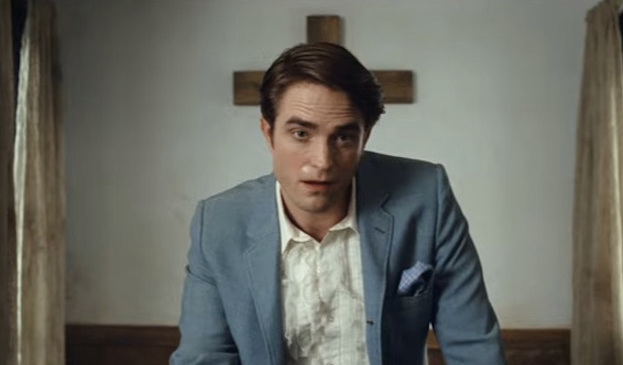by Juan Carlos

“Delusions.”
That is probably what you would say when you see people calling themselves Christians while raising half a million dollars for a domestic terrorist. Or when they continue to support a president that has no respect for human rights unless the human being in question is straight and white and male.
That is also Robert Pattinson’s most memorable line delivery in The Devil All The Time, a recently debuting Netflix original. Telling the sprawling story of religiosity and violence set in post-WWII and pre-Vietnam War America, the film attempts to trace a chain of events which branch out into several storylines which ultimately merge in tragic ways...

In truth it's hard to summarize the 'story' since it really is a multi-generational contemplation on homegrown violence with the heavy presence of faith in the lives of those inflicting and inflicted by the same violence. The presence of a very specific version of Christianity pervades the film, not only in visuals (scenes featuring crosses and church scenes), but in the actual words and actions from the characters which are largely driven by their faith. A father crucifies his son’s dog as a sacrificial offering in the hopes that God will cure his wife of cancer. A pastor kills his wife and in the belief that he has the power to resurrect. A girl being bullied by boys in the school decides to kneel and pray rather than fight back or run away. A gospel song is sung by someone who just finished a murder. The film takes place between wars, but this is a corner of the United States where nothing is ever resolved; people are haunted by the wounds of the past and inflict new ones.
One of the more incisive elements is the depiction of how faith weaponized. Several of the characters pray to God not with humility, but with either business-like dealmaking or straight up shouted demands that God fulfill their wishes. In many ways, the film demonstrates how some don't use faith as a refuge or comfort, but as a weapon for survival or even offense. This kind of "faith" is not a gentle manifestation, but an abrasive verbal medium that channels the ills of America.

Structurally, the screenplay positions us as spectators of this kind of darkly shaded observation. Tom Holland and Robert Pattinson may have received top billing, but their actual storylines do not emerge until the forty five-minute mark. What precedes their narrative thread is a chapter on its own, showing the origins of violence that will affect more characters in the future. In this chapter, Bill Skarsgård and Harry Melling provide haunting portrayals of faithful men whose twisted interpretations of their beliefs cost them. Later in the film, Tom Holland’s slow-burning anger provides a sturdy anchor that will erupt once tensions rise. Sebastian Stan, Jason Clarke, Eliza Scanlen, and Riley Keough also do commendable work, investing in the characters operating in this merciless environment.
Best of all is Robert Pattinson, proving once again why he is one of the most exciting actors working. With his skillful inflections and commitment to the larger-than-life but mysterious pastor, he paints a portrait of highly questionable morality with unsettling attention to detail. Underneath the calm preaching voice is a backhanded sermon. Behind the amiable demeanor is a penchant for sexual harassment. It is a high-wire role that Pattinson handles with remarkable control.
In a story where characters are decidedly in moral gray areas and the haunting presence of wartime violence is looming while the carnage at the homefront already exists, the film toes the line between confrontative and miserabilist. The Devil... is far from perfect. For instead it hardly needed its omniscient narrator when the film itself is already doing so much commenting.

For a country which proclaims itself “religious”, the US history of perpetual violence both at home and overseas is hard to ignore. The hypocritical conjoining of the two is embedded in history and today. Now one must question: what kind of humanity is being fostered when religiosity and violence are the main driving forces in the environment? The answer is as confounding as the relentless domino effect at this film’s core. B+